| Article ID | Journal | Published Year | Pages | File Type |
|---|---|---|---|---|
| 1531903 | Materials Science and Engineering: B | 2006 | 7 Pages |
Porous titania templates were prepared by thermal oxidation followed by electrochemical etching. A thin layer (10 nm) of Ti–2 wt%Al was deposited on 0.25 mm titanium substrates having a thick (100 nm) gold coating on the back surface. The substrates were then thermally oxidized at 800 °C in 1% O2/Ar ambience. Aluminium was used to dope the titanium dioxide films in order to increase the non-stoichiometry in the oxide matrix and hence the conductivity. The as-grown oxide was then electrochemically etched in 0.1 M dilute sulphuric acid medium under 10 V potentiostatic bias for 30 min. For photo-electrochemical etching the oxide samples were exposed to 400-W UV radiations. The crystalline composition of the as-oxidized and electrochemically etched samples was analyzed by glancing angle X-ray diffraction studies (GAXRD) at different incident angles (0.2°, 0.5°, 1.0° and 10°). The surface morphology was studied by scanning electron microscopy (SEM) and the rms roughness of the porous surfaces was obtained from atomic force microscopy (AFM) studies. Resistivity and Hall Effect experiments at room temperature revealed n-type semiconducting nature of the grown oxide. The sensor study with palladium catalytic contact showed high sensitivity and fast response in 500 and 1000 ppm hydrogen. The calculated response time in 1000 ppm hydrogen was 5 s at 300 °C.
